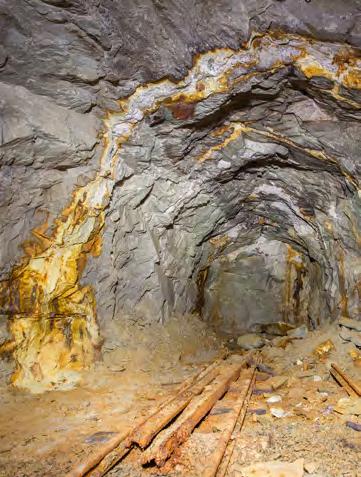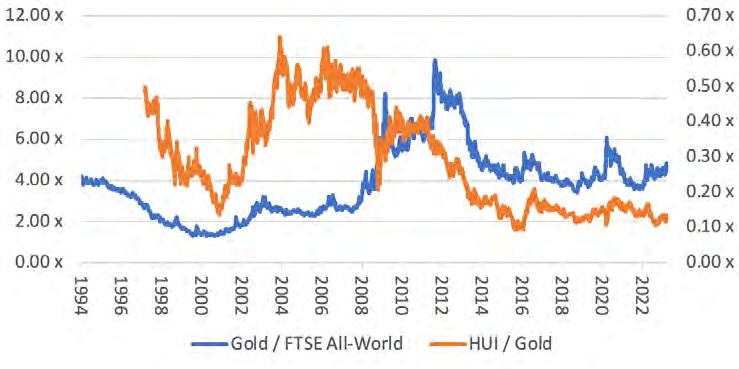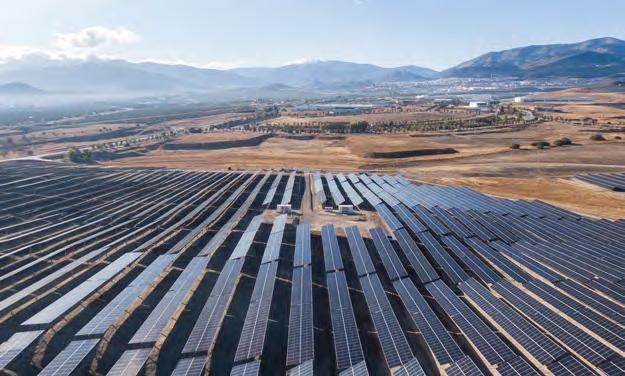
7 minute read
Do gold stocks have the Midas touch right now?
Precious metals miners have been in demand amid surging prices
Any readers who share Warren Buffett’s opinion that gold is an inert, useless lump can turn over the page right now. The Sage of Omaha has long since asserted that an alien invader would dismiss the purportedly precious metal as worthless were they to trip over an ingot upon their arrival from outer space.
That might be going a bit far, as even the most hardened sceptic would probably be prepared to accept that gold could be worth what it costs to get it out of the ground – around $1,200 an ounce, based on the all-in sustained cost (AISC) at the world’s largest quoted gold miner, Newmont Corporation (NEM:NYSE).
Gold bugs may be more interested, however, especially as gold is trying to forge and sustain a break above $2,000 an ounce and in the process reach new all-time highs. Newmont’s decision to increase the value of its offer for fellow gold digger Newcrest Mining (NCM:ASX) does catch the eye and suggests that some UK-listed precious metal producers could yet represent some value for patient portfolio builders.
Golden Words
Whenever a major piece of M&A (merger and acquisition) activity is announced, the single most important items of information are the price paid and the valuation implied. This is because they can determine whether the buyers or potential sellers are getting the better part of the deal and whether the shares of peers in the same industry or sector are looking cheap or not.
The gold mining industry has been busy in this respect. Barrick Gold (GOLD:NYSE) swallowed up Randgold Resources and Newmont snapped up GoldCorp in 2019, while Agnico-Eagle (AEM;NYSE) and Kirkland Lake Gold merged in 2021 and AgnicoEagle and Pan American Silver (PAAS:TSX) have just finished buying and divvying up Yamana Gold. Among the few remaining UK gold miners, Chaarat


Gold (CGH:AIM) looked at Shanta Gold (SHG:AIM) last autumn and although nothing came of that it did suggest that someone, somewhere thought there was value on offer.
Sceptics will dismiss this as an attempt to manufacture growth and momentum where little or none exists, since gold output grows only slowly and the all-in sustained cost (AISC) of producing gold is rising, in no small part due to surging energy and staff costs (trends which dent gold miners’ perceived status as a hedge against inflation).
Gold bugs, however, will argue that the proposed Newmont-Newcrest deal is simply further evidence that gold company executives see value that the stock market is overlooking. The price of gold is up by 32% since the start of 2020 but the NYSE Arca Gold Bugs index, known as the HUI, is up by just 12% over the same period - and all that gain (and more) from the index hails from the rally seen since 1 January this year.
American gold miner Newmont is now getting busy again. It first bid for Australia’s Newmont in February in an all-stock deal that valued the target at $17 billion. The would-be buyer has now increased its all-paper offer to $19.5 billion.
That price tag puts Newcrest on almost 1.7 times historic book, or net asset value. The major, USlisted producers trade on 1.5 times and London market’s gold diggers at 1.1 times – with Centamin (CEY), Resolute Mining (RSG) and Shanta all trading at 1.2 times.
In many cases, the US-listed miners and producers do look to offer greater scale (and lower all-in sustained production costs) than their UKlisted equivalents, but the relative valuations do look to at least partly reflect that. and the differing jurisdictions in which the miners operate. It is also possible to argue that junior miners can offer greater leverage into any upside in gold prices.

Big Picture
Even though the prevailing rate of inflation is slowing, at least in the US, gold is on the move all the same.
Perhaps oil’s fresh gains, in the wake of OPEC’s unexpected production cut of early April, is stoking fears of a 1970s-style second wave of inflation (the first followed the 1973 Yom Kippur war and the second the deposition of the Shah of Iran in 1979, both of which caused crude prices to spike).
Perhaps gold is gearing up for interest rate cuts as wrecked government finances and bloated debts limit how far central banks can tighten policy without doing severe damage, either to the economy, financial markets or both. Perhaps it is no more than a flash in the pan, if you will pardon the expression, but it will be interesting to see if gold mining executives are ahead of the game and being shrewd with their latest round of consolidation or not.
One thing is certain. Gold is trading toward the lower end of its range relative to global equities (as benchmarked by the FTSE All-World since its inception in 1994) and gold miners are trading at near-historic lows relative to the metal’s price (as benchmarked by the HUI and its inception in 1997).

Aquila European Renewables plc (Ticker AERI:LSE) has a diverse renewable energy portfolio that spans six European countries and four power markets, utilizing hydro, solar, and onshore wind technologies.



What do I need to think about before accessing tax-free cash from my pension?
I’ve just turned 57 and I’m considering accessing my pension tax-free cash for the first time. What should I be thinking about?

Anonymous
Tom Selby, AJ Bell Head of Retirement Policy, says:
The ability to access up to 25% of your retirement pot tax-free is a key benefit of pension saving and, crucially, is generally better understood and appreciated than other parts of the pension tax system. Indeed, in many cases the primary motivation behind people accessing their pension for the first time is getting this tax-free cash. This might be because they have earmarked the money for something specific, such as paying off debts, going on holiday or buying a new car.
All-too-often, however, accessing tax-free cash as soon as possible will be driven by a fear a future government will remove the benefit. This can lead to savers making decisions that are not necessarily in their long-term interests. This is one of the reasons a central aim of pension tax policy needs to become giving savers certainty over the rules, including around tax-free cash.
In the meantime, rather than making retirement decisions based on fear of what politicians might do in the future, focus on making decisions based on your short-term needs and long-term goals and try to ignore any rumours and speculation about what may or may not happen to the tax system in the future.
The Rules And Investment Growth
Pension rules allow you to access a quarter of your defined contribution (DC) pension from age 55. This ‘normal minimum pension age’ is set to rise to 57 in 2028.
You should think carefully before taking your tax-free cash, particularly if you are considering withdrawing the money early. You will be removing the cash from an environment where it can grow tax-free, so at the very least make sure you have a plan for it. If you just take the money out of your pension and put it in a bank account earning little to no interest, its value will quickly be eaten away by inflation.
Take, for example, someone with a £200,000 pension who decides to take their maximum 25% tax-free cash of £50,000 at age 55 and puts it into a current account paying 0% interest. If they make no further pension contributions, they will receive no further tax-free cash entitlement – even if their remaining £150,000 fund is left untouched and benefits from investment growth.
If we assume that remaining fund grows by 4% per year after charges, by age 65 it could be worth around £222,000, alongside the £50,000 tax-free cash they withdrew at age 55 (i.e., £272,000 in total).
If, however, they had left their entire £200,000 fund untouched and enjoyed the same 4% investment growth post-charges, by age 65 they could have a total fund worth around £296,000, with £74,000 available tax-free. That is almost 50% more tax-free cash than if they had accessed their pot at age 55.
Understanding Mpaa And Partial Crystallisation
If you have specific things you need to spend money on and your retirement pot is your only option, just accessing your tax-free cash – or a portion of your tax-free cash – can be a sensible option.

Where you also flexibly access taxable income from your pension pot, the ‘money purchase annual allowance’ (MPAA) will be triggered, reducing your annual allowance for making new contributions from £60,000 to £10,000. You will also lose the ability to carry forward up to three years of unused annual allowances from the three previous tax years.
If, however, you just withdraw tax-free cash from your pension, you will not trigger the MPAA and so can retain the full £60,000 annual allowance.
If you do need to take tax-free cash from your pension, you could consider partially ‘crystallising’ some of your pot in drawdown. Crystallising in this context just means choosing a retirement income route. This could allow you to generate the tax-free cash you need, while leaving the ‘uncrystallised’ part of your pension – including the attached taxfree cash entitlement – untouched and with the ability to continue growing.
It is also worth remembering that by withdrawing money out of your pension, you are moving it from an environment where it will usually be free from inheritance tax (IHT) to one where it will form part of your estate.
That is not to say, of course, that people should not access their tax-free cash, but simply to emphasise the importance of considering what you plan to do with the money when you access it. And whatever you do, do not let it fall victim to the ravages of inflation.
WHAT ABOUT DEFINED BENEFIT PENSIONS?
Members of defined benefit (DB) schemes, which promise a guaranteed income from a certain age, usually based on your salary and years of service, also offer a tax-free lump sum, although sometimes this will be offered in exchange for a lower promised pension at retirement. The terms of this DB tax-free lump sum offer will vary from schemeto-scheme.
When considering whether to take this lump sum, it is again important to think about what you will do with the money and the potential impact inflation could have. In addition, where the lump sum is taken in exchange for a reduction in your annual pension, you should make sure this lower pension will still deliver the retirement lifestyle you are hoping for.
DO YOU HAVE A QUESTION ON RETIREMENT ISSUES?
Send an email to asktom@sharesmagazine.co.uk with the words ‘Retirement question’ in the subject line. We’ll do our best to respond in a future edition of Shares
Please note, we only provide information and we do not provide financial advice. If you’re unsure please consult a suitably qualified financial adviser. We cannot comment on individual investment portfolios.








